A United Nations Security Council Washout: India’s Unrevealing Non-Alignment Foreign Policy

India’s refusal to project regional influence leaves others to carry its burden and may signal trouble ahead. Understanding the dynamics of India’s response to its dangerous neighbourhood is increasingly important to global democracy.
India is essential to the “Five Eyes,” the Quad, and to the global fraternity of democratic states more broadly. Australia and India share long-standing bilateral relations built upon democracy, pluralism, and strong interpersonal connections. India matters to Australia because they have similar institutions, values, security interests, and opportunities for economic cooperation. Yet India has become increasingly out of step with its fraternity of democratic nations when called to lock arms with its strategic partners at the United Nations.
India’s History of Non-Alignment
One of India’s central guiding principles during the Cold War was a policy of non-alignment when navigating the hostilities between world superpowers. Such a policy, however, has not been effective in serving India’s own interests or the larger struggle for securing and maintaining the global democratic order.
While India was the first non-socialist country to establish relations with the People’s Republic of China in 1954, India’s defence and strategic concerns are largely defined by its rivalry with China along its northern border and Pakistan on its western flank. India’s rivalry with China was marked by the 1962 Sino-Indian War and ongoing border disputes and skirmishes.
Concerned with China’s growing influence, Primer Minister Jawaharlal Nehru aligned India with the Soviet Union. China’s entry into the nuclear club in 1964 represented an alarming shift in the Indo-Chinese rivalry. India would again look to the Soviet Union, later Russia, as an ally against an emerging China. Despite committing to the Non-Alignment Movement (NAM), India secretly pursued fission technology and in 1974 became the first non-UN Security Council member to conduct a nuclear test.
India had secretly subsumed Canadian Nuclear Agency assistance and later rebuffed the Nuclear Non-Proliferation Treaty (NPT) as an extension of its non-alignment policy. The test was a violation of an understanding between Canadian Prime Minister Louis St. Laurent and Nehru, Prime Minister Indira Gandhi’s father. Since that time, Indian foreign policy has been increasingly veiled in non-alignment in an effort to maintain relationships with both the United States and Russia. Aggrieved by America’s relations with Pakistan, India procured much of its military hardware from the Soviet Union, a dynamic complicated by Pakistan’s entry to the atomic club in 1998.
Contemporary Indian Foreign Policy
Leveraging its strategic importance to the ongoing conflict in Afghanistan, the Indo-Pacific, and Sino-American tensions, India was able to negotiate the US India Defense Technology and Partnership Act (DTP) while at the same time using its relationship with Russia to mitigate the Sino-Russian and Sino-Pak alliances. Washington’s inclusion of India as a “major defence partner” in 2016 allowed India access to defence technology from America. The DTP signalled a new strategic partnership at a time of rising competition from China. The US-India defence trade cooperation was expanded with the Logistics Exchange Memorandum of Agreement (LEMOA), Communications, Compatibility and Security Agreement (COMCASA) and the Industrial Security Agreement (ISA). US defence trade with India increased from almost nothing in 2008 to over $20 billion in 2020.
India is also a member of BRICS ‒ Brazil, Russia, India, China, and South Africa ‒ a group integral to expanding Indo-Russian ties. This includes a “special and privileged strategic partnership” with Russia for strengthening defence cooperation and economic trade. According to the Observatory of Economic Complexity, Russian exports to India in 2019 amounted to $6.7 billion while Indian exports to Russia were estimated at $134 billion.
India also signed on to the International North-South Transport Corridor (INSTC) agreement between India, Russia, and Iran for developing a transport corridor from Mumbai to St. Petersburg. That coalition has since expanded to include Armenia, Azerbaijan, Belarus, Bulgaria, Kazakhstan, Kyrgyzstan, Oman, Syria, Tajikistan, Turkey, and Ukraine.
India’s relationship with Russia has in part been intended to drive a wedge in the Sino-Russian relationship. The Sino-Russian partnership, however, remains stronger than ever. Vladimir Putin and Xi Jinping signed the Sino-Russian agreement in 2021 extending a friendship and cooperation treaty between their countries, which are both at odds with the West.
In February 2022, Putin and Xi declared a “new era” in a sweeping long-term agreement that challenges liberal democracy as a model for world order. The agreement declared a friendship between the two with no limits, and no “forbidden areas of cooperation.” It’s not clear where that leaves New Delhi in its relationship with Russia.
To India’s chagrin, Moscow has also become increasingly cosy with Islamabad. Russia has supplied Pakistan with attack helicopters, and the Russian navy is now a participant in the biennial “Aman” naval exercises hosted by Pakistan. Both Pakistan and China have been invited to the multination “Kavkaz” military exercise hosted by Russia, prompting India’s withdrawal. The Sino-Pakistan friendship has also strengthened. China has invested heavily in the China-Pakistan Economic Corridor (CPEC). The port of Gwadar, on Pakistan’s coast is now owned and operated by a China and likely is a base for People’s Liberation Army (PLA).
India and the Ukraine Crisis
Russia’s invasion of Ukraine now tests Indian strategic, geo-military, and economic alliances in unexpected ways. India has abstained from condemning Russia at the Security Council and stood apart from the 141 of 193 members of the General Assembly in denouncing Russia’s aggression.
India’s evasive response to Russia’s invasion has been disappointing to the US, the European Union, and NATO. India has blatantly offered Russia a back door to economic sanctions. The Countering Russian Influence in Europe and Eurasia Act and new sanctions present considerable new complexity and risk for any future engagement India pursues with Russia. India is left soft-footed on all fronts – floundering in no man’s land between the US, Russia, China, and Pakistan.
India is a member of the Quad, but there too it remains non-committal on the emerging geopolitics of Southeast Asia. It is not surprising that India has been left out of AUKUS, the defence arrangement between the US, Australia, and the United Kingdom. India’s non-aligned policy renders it an unreliable partner in the emerging power dynamics of an evolving world order.
The Chinese Maritime Silk Road project and development of projects in the Indian and Pacific Oceans, part of the Chinese “String of Pearls” strategy, threaten Indian encirclement and challenges Australian and New Zealand security concerns. The struggle is a contest between forces for a democratic world order against those that are authoritarian and autocratic.
For decades Indian foreign policy has exhibited an unwillingness to make the sacrifices required of alliances while still expecting all the benefits. US policymakers, including former Secretary of State Mike Pompeo, former ambassador to India Robert Blackwill, and former senior advisor to the US embassy in New Delhi Ashley Tellis, have raised “serious concerns” about India’s defence decisions — the Indian position is increasingly viewed as “all talk and no show.”
India’s refusal to participate in the Indo-Pacific theatre and back sanctions against Russia leaves others to carry its burden. Its commitment to non-alignment is becoming increasingly duplicitous and dangerous. Non-alignment has provided India with a convenient excuse for non-engagement leaving the rest of the democratic fraternity, including members of the Five Eyes, to carry the load.
Anil Anand is an independent Canadian policy researcher and author with extensive experience in law enforcement, security, and social justice.
This article is published under a Creative Commons License and may be republished with attribution.





